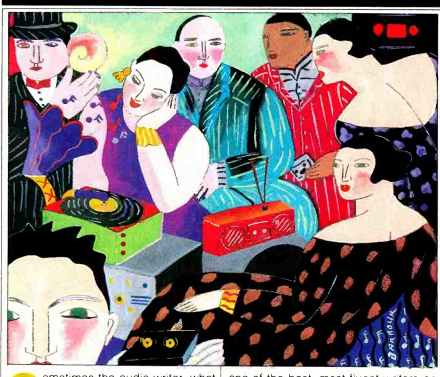WHO KNOWS WHERE OR WHEN

Sometimes the audio writer, what with the endless parade of new products, gets dreadfully jaded: you might call it the "just another syndrome. But to compensate, there are also moments of instant revelation when, suddenly, great vistas open up clear and sharp--it can happen in moments. Wham, wham, like the blows of a pile driver. R-DAT!
Of course, I had long been hearing those improbable initials, more of Al Smith's well-known alphabet soup. I knew what the letters stood for: Rotary-head Digital Audio Tape, in some cassette-like form. So they're reconverting the VCR to audio, I thought lazily. Or maybe it's one of those add-on conversions for your good old analog audio cassette system, the sort of gadget that always comes along when new technology is on hand. I've seen 'em all, from the 78-to-33 turntable converter to the present add-ons to make stereo for your mono TV. Exercises in futility, mostly. You can't convert your old cassette machine to digital! You can't convert an LP to a CD. Yawn.
End of yawn. Those letters kept coming back at me. I got to feeling a bit uneasy as I put them firmly out of mind.
Then it happened. Len Feldman, the Great Explainer himself-to my mind one of the best, most fluent writers on audio technicalities in the business wrote a test report on four DAT recorders for the July issue of Audio. Upon reading it I had a whole new picture of the audio future, sparked by Mr. Feldman's admirable examination of R-DAT in the digital flesh. Blew my mind sky high for hours.
Background. Keep in mind that the analog cassette took a whale of a long time to find its place in the consumer audio market, not as a low-scale miniature system (the original idea), not as a replacement on tape for the LP, but, rather, as something to complement the LP in various ways from the low end of the fi department all the way up to the top. Remember the Nakamichi 1000? The proliferation of uses for this handy miniature tape system was remarkable. With it, at last, "live" person al recording took off, from college lectures to concerts. Today's Walkman-type miniatures in all their variety could not exist without that cassette base, nor could thousands of educational and industrial applications. Nor, most significantly, could the prerecorded music cassette, which today parallels the LP right through the catalogs. And then, long before the VCR, there was copying.
This is where it started! Copy your discs onto tape and don't ever play the originals, except to make another copy. Copy your friends' records.
Small potatoes, I suppose, compared to current VCR operations. But the audio entertainment business was al ready well scrambled by the time the first VCR appeared.
For such a proliferating medium, the cassette has always been somewhat delicate in the technical aspects, its engineering more fragile, nearer the edge of danger, than the relatively sturdy LP. It surely wasn't conceived as the precision mechanism it has be come, almost against its mechanical and magnetic nature. Cassette progress has been perilous-a batch of engineering tightropes. It was barely rescued from its inherent noise problem by the ingenious Dr. Dolby and his Dolby B noise reduction; only the most agonizing precision has kept the mechanics abreast of current hi-fi stability in the sound and the all-important azimuth. Then again, the fi itself would never have been enough to match high-end standards if the tape manufacturers and duplicators had not made continued micro-improvements, the very underpinning of the cassette system. The slightest overt failure in any of these areas might at any time have lopped off vast segments of business. This cassette has gotten where it is by sheer dint of engineering persistence, always available if the profits continue. It has been touch and go, as I see it, from the beginning.
For all of this development, the cassette by now is a dismally outdated system in the face of our new technology, more seriously so than the LP itself, which has had a curious ability to go on getting better in solid and reliable ways. The metal LP master, for instance. The strain on the ever-critical cassette tolerances is now getting obvious; the cassette has about hit its engineering ceiling. Only its incredibly wide usefulness and popularity keep it afloat as a big business. (Fortunately, the fi isn't too important in plenty of cassette areas.) What this little audio device has had all along, what made it revolutionary when first introduced, is a pair of attributes that are more vital than ever to day: Automation and miniaturization.
[...]
(by: EDWARD TATNALL CANBY; adapted from Audio magazine, Dec. 1987)
= = = =